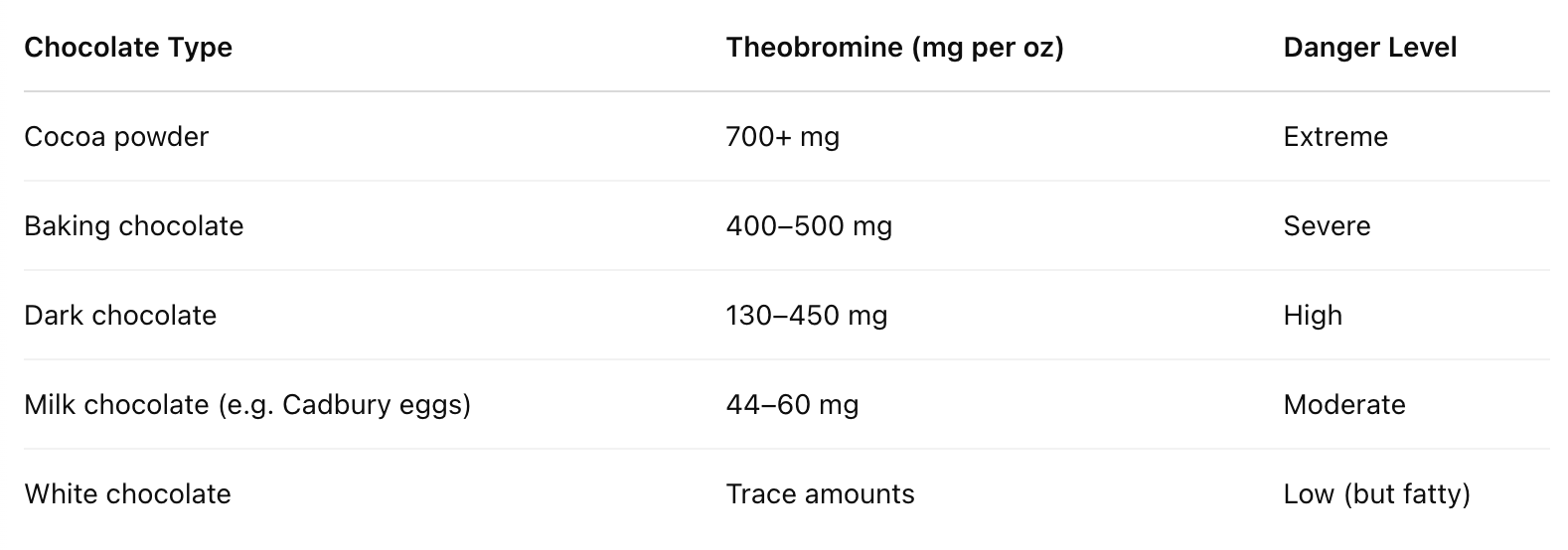Easter Warning: Why Chocolate Eggs Are Dangerous for Dogs
Easter is a time filled with family, fun, and a serious amount of chocolate. From foil-wrapped eggs to rich dark chocolate bunnies, it’s everywhere – on tables, in hampers, and hidden in gardens for egg hunts. While it may be a treat for humans, chocolate can be fatal for dogs.
Every Easter, veterinary clinics across the UK report a spike in emergency visits due to dogs eating chocolate. Many cases involve well-meaning families who simply weren’t aware of how dangerous even a small amount can be. This blog explains why chocolate is toxic to dogs, how much is too much, what symptoms to look out for, and how to keep your dog safe this Easter.
Why Chocolate Is Toxic to Dogs – Especially at Easter
Chocolate contains two substances that are poisonous to dogs: theobromine and caffeine. These belong to a group of chemicals called methylxanthines, and dogs process them much more slowly than humans. This means even a small amount of chocolate can result in a toxic build-up in a dog’s body, leading to serious health issues or even death.
Easter makes things particularly risky because of how much chocolate is around. Chocolate eggs are often left on low tables, hidden around the house or garden during egg hunts, or left open after unwrapping. Children may also unknowingly offer chocolate to a pet thinking they’re sharing a treat. With so many tempting smells within easy reach, dogs can quickly scoff down dangerous amounts before anyone realises.
How Chocolate Affects a Dog’s Body
Once consumed, chocolate’s toxins affect multiple systems in the dog’s body, including the nervous system, heart, digestive tract, and kidneys. The effects can begin within 2 to 12 hours after ingestion and may last for over 24 hours.
Dogs experiencing chocolate poisoning may first show signs such as vomiting or diarrhoea, which often include pieces of foil or packaging if they consumed wrapped treats. As the condition worsens, dogs may become restless, hyperactive or begin panting heavily. You may also notice increased thirst and urination as the body tries to flush out the toxins.
The most dangerous symptoms involve the heart and nervous system. A dog may develop a rapid or irregular heartbeat, which can progress to tremors, muscle stiffness, seizures, or even collapse. These signs can be life-threatening, particularly in small dogs or those with underlying heart conditions.
How Much Chocolate Is Too Much?
There is no “safe” amount of chocolate for dogs, but the type of chocolate, the amount consumed, and your dog’s size and weight all play a role in how toxic it may be.
Dark chocolate, cocoa powder, and baking chocolate contain the highest levels of theobromine, making them the most dangerous. Milk chocolate, while lower in theobromine, can still be harmful – especially in small dogs. White chocolate contains only trace amounts of theobromine but is high in fat and sugar, which can cause stomach upset or trigger pancreatitis.
Here’s a general guide to theobromine content per ounce (28g):
For context, just 50 grams of dark chocolate could be enough to cause serious symptoms in a 10kg dog. For small breeds, even a couple of milk chocolate buttons can result in vomiting or heart issues.
To calculate the risk based on your dog’s size, use the PDSA Chocolate Toxicity Calculator – it’s quick, easy, and UK-specific.
What to Do if Your Dog Eats an Easter Egg
If you suspect your dog has eaten chocolate – even a small amount – don’t wait. Act immediately.
First, remove any remaining chocolate or wrappers to stop further ingestion. Try to estimate how much was eaten, what type of chocolate it was, and keep the packaging to show the vet.
Next, contact your vet straight away.
Do not try to make your dog vomit unless specifically instructed by a professional – doing it incorrectly can cause more harm than good.
At the clinic, your vet may induce vomiting, give activated charcoal to absorb any remaining toxins, and provide IV fluids to help flush out the theobromine. In more serious cases, medications may be needed to manage seizures, heart rate abnormalities, or tremors.
How to Keep Your Dog Safe This Easter
Prevention is the best protection. Here are practical tips to keep your dog out of the vet’s office this Easter:
1. Keep chocolate out of reach.
Store Easter eggs and chocolate treats well above your dog’s reach – think high cupboards, locked hampers, or fridges. Don’t leave chocolates on coffee tables, sofas or counters where curious noses can reach them.
2. Avoid using chocolate in Easter egg hunts.
If you're organising a garden or house egg hunt, use plastic eggs or pet-safe alternatives instead. Dogs are natural scavengers and can sniff out chocolate hidden in hedges, flower beds, or behind furniture long after the hunt is over.
3. Teach children the risks.
Make sure kids know not to feed chocolate or sweets to the dog – even out of kindness. Explain in simple terms that what’s safe for us is dangerous for pets.
4. Watch out for foil wrappers.
Dogs often swallow wrappers along with the chocolate, which can lead to choking or intestinal blockages. Signs of obstruction include vomiting, bloating, or straining to defecate.
5. Treat them safely.
Give your dog their own Easter treat – something specially made for dogs and completely chocolate-free. Many UK pet shops now offer dog-safe Easter eggs made from carob or yogurt-based alternatives.
Final Thoughts: Keep the Chocolate, Save the Dog
Chocolate poisoning in dogs is entirely preventable – but it remains one of the most common pet emergencies every Easter. By storing chocolate safely, educating your family, and acting fast in an emergency, you can ensure your dog enjoys Easter as much as you do – without a trip to the vet.
So this Easter, enjoy your chocolate... but make sure it’s just for humans.


